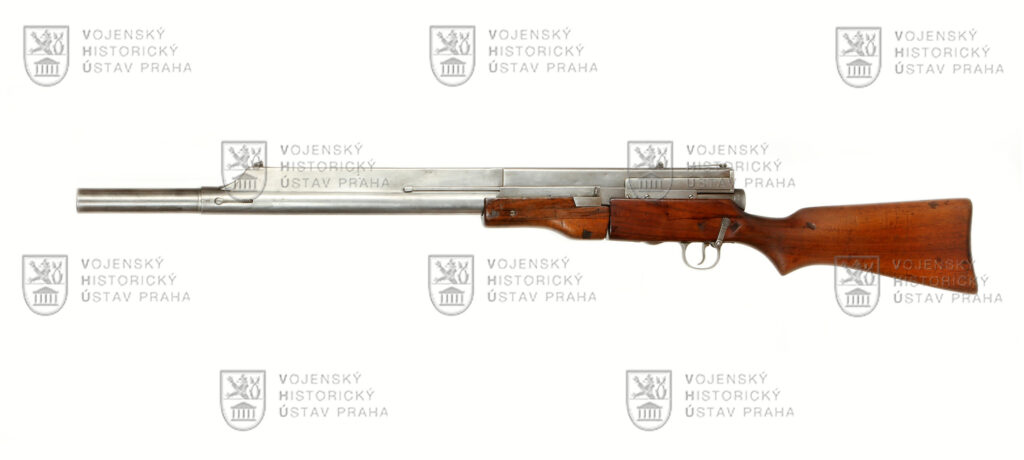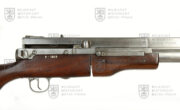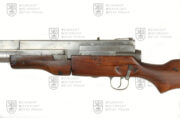
Netsch crossbow - carbine
Photogallery
[ ](javascript:;?_x_tr_sl=cs&_x_tr_tl=en&_x_tr_hl=en&_x_tr_pto=sc)[
](javascript:;?_x_tr_sl=cs&_x_tr_tl=en&_x_tr_hl=en&_x_tr_pto=sc)[ ](javascript:;?_x_tr_sl=cs&_x_tr_tl=en&_x_tr_hl=en&_x_tr_pto=sc)[
](javascript:;?_x_tr_sl=cs&_x_tr_tl=en&_x_tr_hl=en&_x_tr_pto=sc)[ ](javascript:;?_x_tr_sl=cs&_x_tr_tl=en&_x_tr_hl=en&_x_tr_pto=sc)[
](javascript:;?_x_tr_sl=cs&_x_tr_tl=en&_x_tr_hl=en&_x_tr_pto=sc)[ ](javascript:;?_x_tr_sl=cs&_x_tr_tl=en&_x_tr_hl=en&_x_tr_pto=sc)
](javascript:;?_x_tr_sl=cs&_x_tr_tl=en&_x_tr_hl=en&_x_tr_pto=sc)
The beginnings of arming the Czechoslovak Republic. of the army was accompanied by the testing of a number of domestic and foreign designs, which mainly concerned automatic weapons. While there was no dispute about the acute need for light machine guns, the arms department of the MNO was not entirely clear about the future use of automatic rifles, then temporarily referred to as crossbows. However, he did not let them out of his sight, because the representatives of the French military mission were interested in the promotion of a light automatic weapon, controlled only by the shooter.
After unsuccessfully offering his submachine guns, the Slovak gunsmith and designer Josef Netsch turned his attention to weapons with higher performance, and the result was an unusual design of a self-loading rifle, demonstrated for the first time to the members of the armament commission on December 21, 1921 at the military shooting range in Milovice.
The demonstrated sample only had a self-loading function, the supply system consisted of a drum magazine with a capacity of 10 cartridges, and the total length of the barrel was approx. 490 mm. All members of the commission took part in the shooting, and in general the rifle was found to be satisfactory just because it achieved a scattering pattern of 15 x 20 cm at a distance of 100 steps. During the demonstration, the committee fired around 300 rounds from Netsch’s rifle. The shooting was not without problems, in particular the magazine occasionally fell out due to the shocks of the weapon during shooting. In addition to minor comments, a request was made at the end of the informative tests that influenced the further development of Netsch’s weapon. It concerned the possibility of continuous shooting, i.e. burst shooting.
The second demonstration of Netsch’s rifle took place on February 4, 1922, again in Milovice. At that time, the weapon already met the requirements from the December demonstration and could fire in both modes. The demonstrated sample had a weight of 5.8 kg and was supplied with drum magazines for 10 and 20 cartridges. During the demonstration, the commission fired 12 bursts of 10 rounds, after which the release bridge protrusion connecting the bolt carrier to the gas tube broke, ending the firing. Regardless of the defect, the gun made a promising impression on the committee.
The conditions imposed on the crossbow (automatic rifle) were profiled by the MNO at the beginning of 1923, when it sent domestic and foreign manufacturers to the competition. It required a weapon weight of up to 6.5 kg without a magazine, supply with a removable magazine located so that it does not interfere with the handling of the weapon, especially when aiming, a theoretical cadence of 100-300 rounds per minute, the ability to fire 100 rounds in a continuous series (taking into account the necessary replacements magazines) without the weapon seizing or malfunctioning, and guaranteed function when dirty and with unlubricated cartridges. The crossbow was supposed to be operated by only one man, carried on the shoulder as a standard repeater and with the possibility of a bayonet.
The original intention of the artillery and weapons department of the MNO was to order 15 crossbows and two machine guns, working on the same principle, from Netsche for tests. Since the completion of the order exceeded the designer’s capabilities, he began to negotiate with Česká zbrojovka in Strakonice through Škoda’s plants. The order from May 20, 1922 for the production of 25 crossbows and two machine guns was indeed predisposed by Netsch to České zbrojovce with the knowledge of MNO.
The first copy of Netsch’s rifle was completed on August 16, and the factory invited the designer to Strakonic for tests. However, the production and verification of the function did not go as fast as it should have. In mid-October 1922, the armory had only two rifles ready, with the prospect of completing the entire order by the end of November. However, the reality was different.
In its letter dated November 6, the armory reported that only four examples were produced, but that the remaining 21 pieces should be completed by the end of the month. In addition, it offered the arms department the delivery of one specimen in carbine design, which it produced for internal factory tests. The concept of the Netsch submachine gun in carbine design included a weapon with a total length of 1,130 mm and a weight of 6.03 kg. At the same time, the armory reported that "the length of a normal Netsch automatic rifle is 1,350 mm and it weighs 6.8 kg without a magazine. A magazine for 10 rounds weighs without rounds 0.45 kg, with 10 rounds 0.65 kg.
Regarding the specimen in the carbine version, the MNO zbrojovce told it to send it for comparative tests to the examination committee in Milovice. Apparently, this did not happen in the end, since such a weapon does not appear on any of the surviving delivery notes, and it does not appear from the relatively austere test records that the commission tested a similar specimen.
The surviving shorter example of Netsch’s crossbow is undoubtedly identical to the piece whose photographs are preserved in the company archive of the former Česká zbrojovka. However, its parameters do not correspond to the carabiner design that the factory offered for comparative tests. It has no company markings, only the number 001 is faintly stamped on the left side of the bolt housing, and the locking screws are marked with the numbers 1 and 2. Based on the design, one can rather judge that this is a weapon made by Josef Netsch and imported to the factory.
The specimen with production number 001 was acquired by the museum in 1995 by transfer from Prototypy, as, Brno.
TECHNICAL DATA:
- Caliber: 7.92 mm Mauser
- Total length: 1,076 mm
- Barrel length: 500 mm
- Sight length: 472 mm
- Magazine capacity: 10 rounds
- Weapon weight without magazine: 5,810 g
